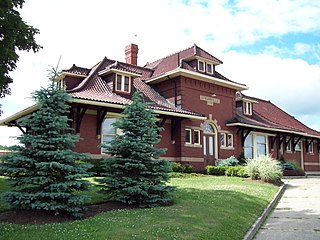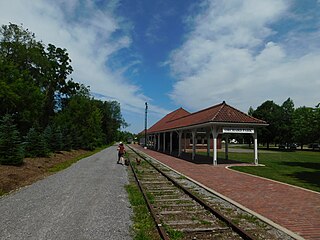Related Research Articles

Medway is a local government district with borough status in the ceremonial county of Kent, South East England. Its council, Medway Council, is a unitary authority, being a district council which also performs the functions of a county council; it is independent from Kent County Council. The borough had a population of 278,016 in 2019. It was formed in 1998 by merging the boroughs of Rochester-upon-Medway and Gillingham. The borough contains the towns of Chatham, Gillingham, Rainham, Rochester and Strood, which are collectively known as the Medway Towns.

The Rochester Industrial and Rapid Transit Railway, more commonly known as the Rochester subway, was a light rail rapid transit line in the city of Rochester, New York that operated from 1927 to 1956. The subway was constructed in the bed of the old Erie Canal, which allowed the route to be grade-separated for its entire length. Two miles (3.2 km) of the route through downtown were constructed in a cut-and-cover tunnel that became Broad Street, and the only underground portion of the subway.

Rochester railway station is on the Chatham Main Line in England, serving the town of Rochester, Kent. It is 33 miles 61 chains (54.3 km) down the line from London Victoria and is situated between Sole Street and Chatham.

Sole Street railway station is on the Chatham Main Line in England, serving the village of Sole Street, near Cobham, Kent. It is 26 miles 71 chains (43.3 km) down the line from London Victoria and is situated between Meopham and Rochester. The station is managed by Southeastern.

Rochester railway station is located on the Deniliquin line in Victoria, Australia. It serves the town of Rochester, and opened on 19 September 1864.

Springville station is a historic train station located at Springville, Erie County, New York. It was built in 1910 by the Buffalo, Rochester and Pittsburgh Railway, and is a 1 1/2-story, rectangular brick building with a hipped roof. It consists of a central two-story tower section flanked by wings.

Chatham Central was the terminus of the Chatham Extension from Strood serving the towns of Chatham and Rochester.
Rochester Common was a station on the Chatham Extension from Strood serving the town of Rochester.

Rochester Bridge railway station served Rochester and Strood in Kent, England.
Strood (1st) was a terminus of the South Eastern Railway located in Strood and serving also the towns of Chatham and Rochester. It closed for passengers in 1856 when the present Strood station was opened. The site was then used as a sidings yard until around 1990. It is now occupied by housing development and industrial units.

Orchard Park station is a historic railway station located at Orchard Park in Erie County, New York. It was constructed in 1911 and served passenger trains until the 1950s.
Chester is an unincorporated community in Marion Township, Olmsted County, Minnesota, United States. It is located immediately east of Rochester along U.S. Highway 14 near Olmsted County Roads 19 and 119. Chester Woods Park is nearby.
General Motors is a former Rochester Industrial and Rapid Transit Railway station and streetcar carhouse located next to the Rochester Products Division in Rochester, New York, United States. It opened in 1937 as a one-stop extension from the former terminus at Driving Park, and was closed in 1956 along with the rest of the line. The maintenance buildings still stand.

Edgerton Park is a former Rochester Industrial and Rapid Transit Railway station located in Rochester, New York. It was named after Edgerton Park, about 300 feet (90 m) away, where the Monroe County Fair was held each September. Until summer 1938 the station had been named Felix Street. Other destinations at the station included Edgerton Park Arena. The station was closed in 1956, along with the arena and the rest of the line and coinciding with the fair's relocation to new facilities in suburban Henrietta.
Main & Oak is a former Rochester Industrial and Rapid Transit Railway station located in Rochester, New York. The line was near a connection to the Baltimore and Ohio Railroad and the Oak Street Loop. It was closed in 1956 along with the rest of the line.

Court Street was a former Rochester Industrial and Rapid Transit Railway station located in Rochester, New York. It was closed in 1956 along with the rest of the line.
Monroe is a former Rochester Industrial and Rapid Transit Railway station located in Rochester, New York. It was closed in 1956 along with the rest of the line.
Rowlands is a former Rochester Industrial and Rapid Transit Railway loop and station located in Brighton, New York. It was closed in 1956 along with the rest of the line. The station was named after local property owner Elwell Rowland. The Rochester and Eastern Rapid Railway connected to the Subway at Rowlands after 1927, abandoning their line up Monroe Avenue to the city line.
Bhoke railway station is a station on the Konkan Railway. It is located at a distance of 196.432 km (122.1 mi) from the origin at the north side, i.e., Roha railway station, which marks the end of the jurisdiction of the Central Railway zone of Indian Railways. The preceding station on the line is Ukshi railway station, and the next station is Ratnagiri railway station. There is a 6.5-kilometer-long tunnel known as Karbude Tunnel located on the Konkan Railway, situated between UKSHI and Bhoke station. Karbude Tunnel is the longest tunnel on the Konkan railway line. It remained India's longest rail tunnel until the Indian Government approved the planning and construction of the Pir Panjal Railway Tunnel. The Bhoke railway station on the Konkan railway track (line) lies between two railway tunnels.

Pattukkottai railway station is an NSG–6 category Indian railway station in Tiruchirappalli railway division of Southern Railway zone. It is a railway station serving the town of Pattukkottai in Tamil Nadu, India. This station was first opened on 20.10.1902 along with muthupettai to pattukottai section before independence. This station located in the thiruvarur -karaikudi section one of the longest stretch in Tiruchirappalli railway division.
References
- ↑ Amberger, Ron; Barrett, Dick; Marling, Greg (1985). Canal Boats, Interurbans & Trolleys: The Story of the Rochester Subway. Rochester, NY: Rochester Chapter, National Railway Historical Society. pp. 61–65. ISBN 0-9605296-1-6.